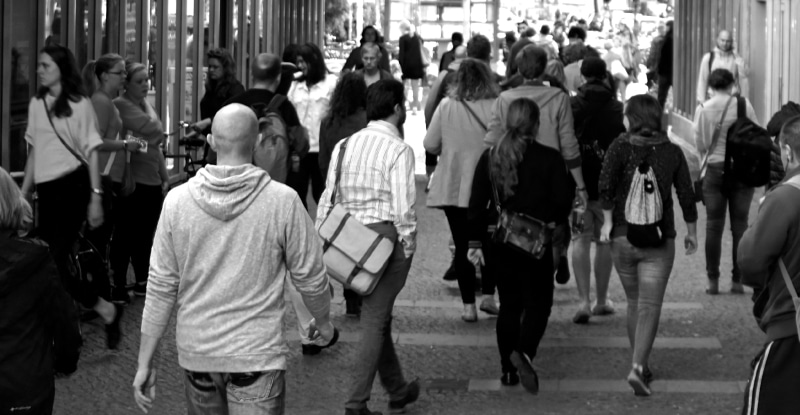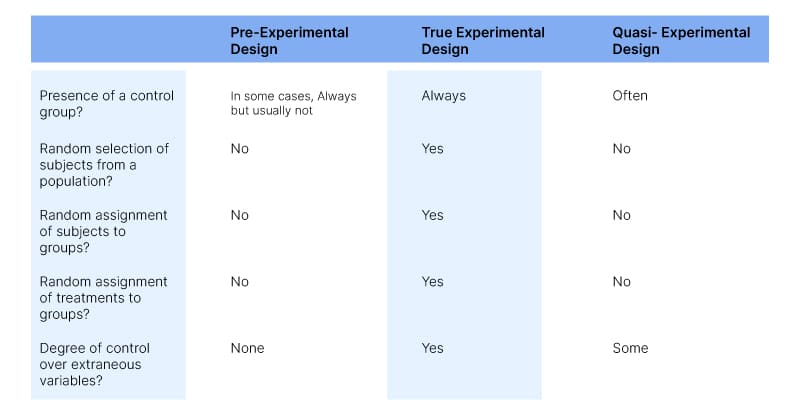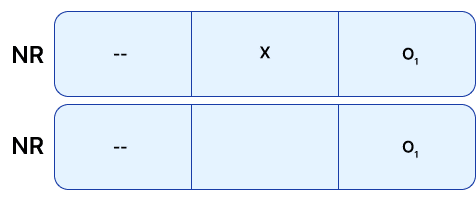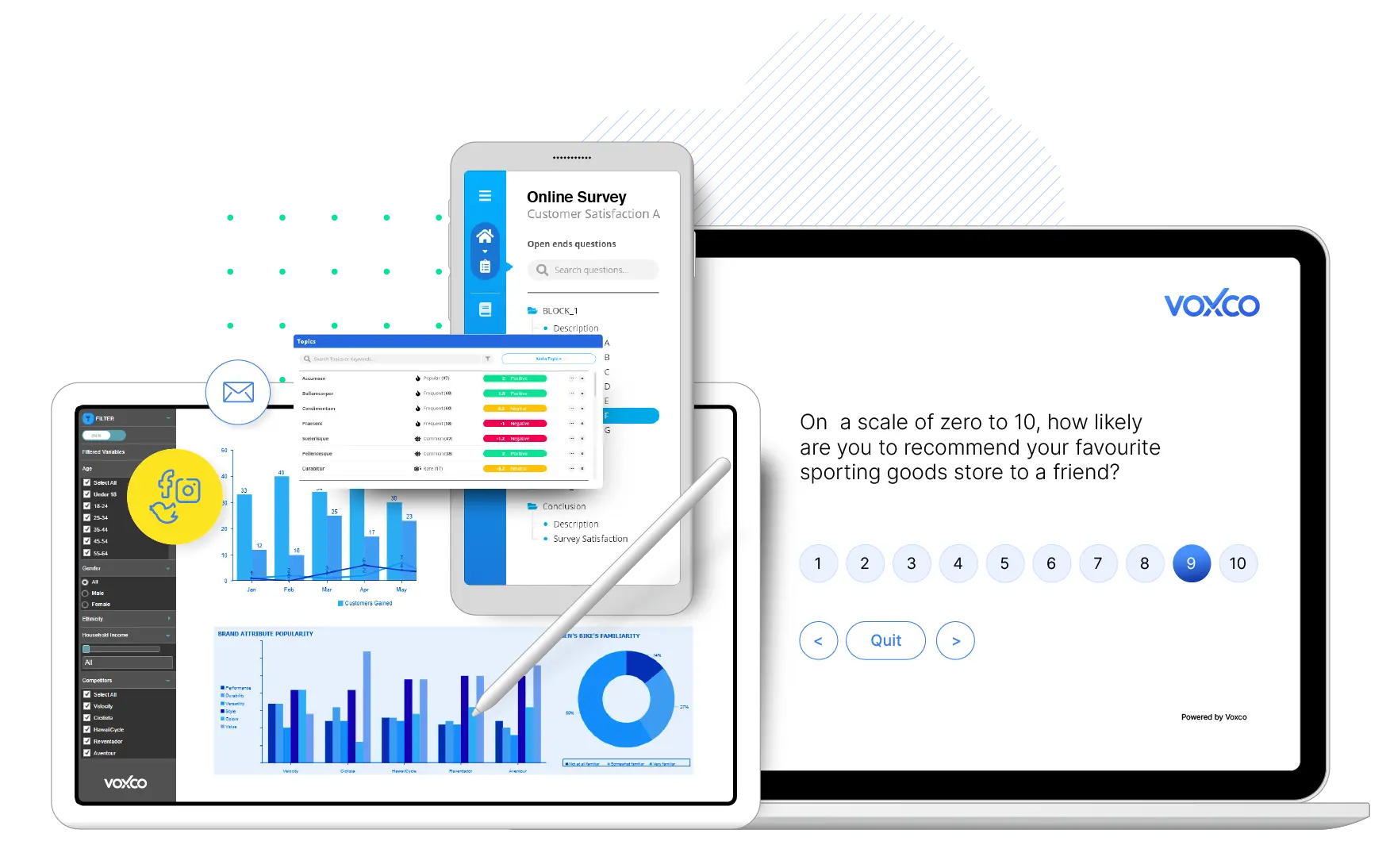What Type of Experimental Design Is Being Used

Pre-experimental design: Definition, types & examples
What are Pre-Experimental Designs?
As the name suggests, pre-experimental design happens even before the true experiment starts. This is done to determine the researchers' intervention on a group of people. This will help them tell if the investment of cost and time for conducting a true experiment is worth a while. Hence, pre-experimental design is a preliminary step to justify the presence of the researcher's intervention.
This is a factor that prevents an experiment from being a true experiment. The pre-experimental approach helps give some sort of guarantee that the experiment can be a full-scale successful study.
Pre-experimental design being the simplest form of exploratory design, include one or more than one experimental group to be observed against certain treatment. Let us understand how pre-experimental design is different from the true and quasi-experiments:
See Voxco survey software in action with a Free demo.

The above table tells us pretty much about the working of the pre-experimental designs. So we can say that it is actually to test treatment, and check whether it has the potential to cause a change or not. For the same reasons, it is advised to perform pre-experiments to define the potential of a true experiment.
What are the types of Pre-Experimental Designs?
Assuming now you have a better understanding of what the whole pre-experimental design concept is, it is time to move forward and look at its types and their working:
One-shot case study design
- This design practices the treatment of a single group.
- It only takes a single measurement after the experiment.
- One-shot case study design only analyses post-test results.

One-shot case study compares the post-test results to the expected results. It makes clear what the result is and how the case would have looked if the treatment wasn't done.
Example: A team leader wants to implement a new soft skills program in the firm. The employees can be measured at the end of the first month to see the improvement in their soft skills. The team leader will know the impact of the program on the employees.
One-group pretest- posttest design
- Like the previous one, this design also works on just one experimental group.
- But this one takes two measures into account.
- A pre-test and a post-test are conducted.

As the name suggests, it includes one group and conducts pre-test and post-test on it. The pre-test will tell how the group was before they were put under treatment. Whereas post-test determines the changes in the group after the treatment. This sounds like a true experiment, BUT being a pre-experiment design, it does not have any control group.
Example: In the above example, the team leader here will conduct two tests. One before the soft skill program implementation to know the level of employees before they were put through the training. And a post-test to know their status after the training. Now that he has a frame of reference, he knows exactly how the program helped the employees.

Static-group comparison
- This compares two experimental groups.
- One group is exposed to the treatment.
- The other group is not exposed to the treatment.
- The difference between the two groups is the result of the experiment.

As the name suggests, it has two groups, which means it involves a control group too. This shouldn't be a surprise because as the table above shows that in some cases pre-experimental design has a control group. In static-group comparison design, the two groups are observed as one goes through the treatment when the other does not. They are then compared to each other to determine the outcome of the treatment.
Example: The team lead decides one group of employees to get the soft skills training while the other group remains as a control group and are not exposed to any program. He then compares both the groups and finds out the treatment group has evolved in their soft skills than the control group.
Due to such working, static-group comparison design is generally perceived as a quasi-experimental design too.
What are the characteristics of Pre-Experimental Designs?
In this section, let us point down the characteristics of pre-experimental design:
- Generally uses only one group for treatment which makes observation simple and easy.
- Validates the experiment in the preliminary phase itself.
- Pre-experimental design tells the researchers how their intervention will affect the whole study.
- As they are conducted in the beginning, pre-experimental designs give evidence for or against their intervention.
- It does not involve the randomization of the participants.
- It generally does not involve the control group, but in some cases where there is a need for studying the control group against the treatment group, static-group comparison comes into the picture.
- The pre-experimental design gives an idea about how the treatment is going to work in case of actual true experiments.
What is the validity of results in Pre-Experimental Designs?
Validity means a level to which data or results reflect the accuracy of reality. And in the case of pre-experimental research design, it is a tough catch. The reason being testing a hypothesis or dissolving a problem can be quite a difficult task, let's say close to impossible. This being said, researchers find it challenging to generalize the results they got from the pre-experimental design, over the actual experiment.
As pre-experimental design generally does not have any comparison groups to compete for the results with, that makes it pretty obvious for the researchers to go through the trouble for believing its results. Without comparison, it is hard to tell how significant or valid the result is. Because there is a chance that the result is occurred due to some uncalled changes in the treatment, maturation of the group or is it just sheer chance.
Let's say all the above parameters work just in favour of your experiment, you even have a control group to compare it with, but that still leaves us with one problem. And that is what "kind" of groups we get for the true experiments. It is possible that the subjects in your pre-experimental research were a lot different from the subjects you have for the true experiment. If this is the case, even if your treatment is constant, there is still going to be a change in your results.
Advantages of Pre-Experimental Designs
- Cost-effective due to its easy process.
- Very simple to conduct.
- Efficient to conduct in the natural environment.
- It is also suitable for beginners.
- Involves less human intervention.
- Determines how your treatment is going to affect the true experiment.
Disadvantages of Pre-Experimental Designs
- It is a weak design to determine causal relationships between variables.
- Does not have any control over the research.
- Possess a high threat to internal validity.
- Researchers find it tough to examine the results' integrity.
- The absence of a control group makes the results less reliable.
Explore all the survey question types possible on Voxco
Explore all the survey question types possible on Voxco
FAQs:
Pre-experimental design is a research method that happens before the true experiment and determines how the researcher's intervention will affect the experiment.
An example of a pre-experimental design would be a gym trainer implementing a new training schedule for a trainee.
Characteristics of pre-experimental design include its ability to determine the significance of treatment even before the true experiment is performed.
Researchers want to know how their intervention is going to affect the experiment. So even before the true experiment starts, they carry out a pre-experimental research design to determine the possible results of the true experiment.
The pre-experimental design deals with the treatment's effect on the experiment and is carried out even before the true experiment takes place. While a true experiment is an actual experiment, it is important to conduct its pre-experiment first to see how the intervention is going to affect the experiment.
The true experimental design carries out the pre-test and post-test on both the treatment group as well as a control group. whereas in pre-experimental design, control group and pre-test are options. it does not always have the presence of those two and helps the researcher determine how the real experiment is going to happen.
The main difference between a pre-experimental design and a quasi-experimental design is that pre-experimental design does not use control groups and quasi-experimental design does. Quasi always makes use of the pre-test post-test model of result comparison while pre-experimental design mostly doesn't.
Non-experimental research methods majorly fall into three categories namely: Cross-sectional research, correlational research and observational research.
Explore Voxco Survey Software



CSAT Score Formula
CSAT Score Formula SHARE THE ARTICLE ON Share on facebook Share on twitter Share on linkedin Table of Contents What is CSAT? Customer Satisfact ...


Analyzing Survey Data
Analyzing Survey Data Voxco is trusted by 450+ Global Brands in 40+ countries See what question types are possible with a s ...


What Type of Experimental Design Is Being Used
Source: https://www.voxco.com/blog/pre-experimental-design-definition-types-examples/
0 Response to "What Type of Experimental Design Is Being Used"
Enregistrer un commentaire